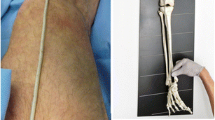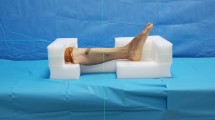Abstract
Introduction
Accurate restoration of mechanical alignment is an important factor in reconstructive surgery of the lower extremity. Conventional intraoperative methods, such as using an electrocautery cable, provide only a momentary evaluation of alignment. In this study, we evaluated a novel technique using a laser emitter, which projected the mechanical axis of the lower extremity, providing continuous intraoperative information on alignment.
Materials and methods
Alignment of 16 cadaver lower extremities was measured using the electrocautery cable method, the laser method, and CT scan as the standard measurement. The mechanical axis was defined by a line from the center of the femoral head to the center of the ankle. For simplifying measurements the intersection with the tibial plateau was divided into percentages from the medial border (0 %) to the lateral border (100 %). For using the laser method a laser emitting and laser catching device was developed, which is positioned and centered on the femoral head and the ankle using an image intensifier. By catching the laser on the knee region the actual mechanical axis is marked.
Results
The data demonstrated good correlation of the laser method when compared to the cable method (P = 0.44). Comparison of the average mechanical axis between cable method and CT (P = 0.819) and laser method and CT (P = 0.647) did not show a statistically significant difference. Average radiation time in comparison between cable method and laser method showed a statistically significant difference (P = 0.013), with the laser method requiring more radiation time.
Conclusion
Determination of the mechanical axis during surgery remains a difficult clinical problem. Restoration of alignment is an important prognostic factor for surgical outcome. Based on these data, the laser method represents a simple, yet effective tool for continuous intraoperative evaluation of lower extremity alignment.








Similar content being viewed by others
References
Bathis H, Perlick L, Tingart M, Luring C, Zurakowski D, Grifka J (2004) Alignment in total knee arthroplasty. A comparison of computer-assisted surgery with the conventional technique. J Bone Joint Surg Br 86(5):682–687
Chao EY, Neluheni EV, Hsu RW, Paley D (1994) Biomechanics of malalignment. Orthop Clin North Am 25(3):379–386
FDA Safety Notification: Risk of Eye and Skin Injuries from High-powered, Hand-held Lasers Used for Pointing or Entertainment. (2010). http://www.fda.gov/medicaldevices/safety/alertsandnotices/ucm237129.htm. Accessed 02/07/2014
Hankemeier S, Hufner T, Wang G, Kendoff D, Zheng G, Richter M, Gosling T, Nolte L, Krettek C (2005) Navigated intraoperative analysis of lower limb alignment. Arch Orthop Trauma Surg 125(8):531–535
Hernigou P, Medevielle D, Debeyre J, Goutallier D (1987) Proximal tibial osteotomy for osteoarthritis with varus deformity. A ten to thirteen-year follow-up study. J Bone Joint Surg Am 69(3):332–354
Hoke D, Jafari SM, Orozco F, Ong A (2011) Tibial shaft stress fractures resulting from placement of navigation tracker pins. J Arthroplasty 26(3):504 (e505-508)
Hsu RW, Himeno S, Coventry MB, Chao EY (1990) Normal axial alignment of the lower extremity and load-bearing distribution at the knee. Clin Orthop Relat Res 255:215–227
Jeffery RS, Morris RW, Denham RA (1991) Coronal alignment after total knee replacement. J Bone Joint Surg Br 73(5):709–714
Jung HJ, Jung YB, Song KS, Park SJ, Lee JS (2007) Fractures associated with computer-navigated total knee arthroplasty. A report of two cases. J Bone Joint Surg Am 89(10):2280–2284
Krettek C, Miclau T, Grun O, Schandelmaier P, Tscherne H (1998) Intraoperative control of axes, rotation and length in femoral and tibial fractures technical note. Injury 29(Suppl 3):C29–C39
Liodakis E, Kenawey M, Liodaki E, Mommsen P, Krettek C, Hankemeier S (2010) The axis-board: an alternative to the cable technique for intraoperative assessment of lower limb alignment. Technol Health Care 18(3):165–171
Lotke PA, Ecker ML (1977) Influence of positioning of prosthesis in total knee replacement. J Bone Joint Surg Am 59(1):77–79
Massai F, Conteduca F, Vadala A, Iorio R, Basiglini L, Ferretti A (2010) Tibial stress fracture after computer-navigated total knee arthroplasty. J Orthop Traumatol 11(2):123–127
Matthews LS, Goldstein SA, Malvitz TA, Katz BP, Kaufer H (1988) Proximal tibial osteotomy. Factors that influence the duration of satisfactory function. Clin Orthop Relat Res 229:193–200
Paley D, Herzenberg JE, Tetsworth K, McKie J, Bhave A (1994) Deformity planning for frontal and sagittal plane corrective osteotomies. Orthop Clin North Am 25(3):425–465
Paley D, Tetsworth K (1992) Mechanical axis deviation of the lower limbs. Preoperative planning of multiapical frontal plane angular and bowing deformities of the femur and tibia. Clin Orthop Relat Res 280:65–71
Papachristou G (2004) Photoelastic study of the internal and contact stresses on the knee joint before and after osteotomy. Arch Orthop Trauma Surg 124(5):288–297
Quack VM, Kathrein S, Rath B, Tingart M, Luring C (2012) Computer-assisted navigation in total knee arthroplasty: a review of literature. Biomed Tech (Berl) 57(4):269–275
Saleh M, Harriman P, Edwards DJ (1991) A radiological method for producing precise limb alignment. J Bone Joint Surg Br 73(3):515–516
Sharma L, Song J, Felson DT, Cahue S, Shamiyeh E, Dunlop DD (2001) The role of knee alignment in disease progression and functional decline in knee osteoarthritis. JAMA 286(2):188–195
Sprenger TR, Doerzbacher JF (2003) Tibial osteotomy for the treatment of varus gonarthrosis. Survival and failure analysis to twenty-two years. J Bone Joint Surg Am 85(A (3)):469–474
Ziahosseini K, Doris JP, Turner GS (2010) Laser eye injuries. Maculopathy from handheld green diode laser pointer. BMJ 340:c2982. doi:10.1136/bmj.c2982 (Comment in: Laser eye injuries. Further warnings about laser pointers, [BMJ, PMID 20530564])
Conflict of interest
Each author certifies that he has no commercial associations (e.g., consultancies, stock ownership, equity interest, patent/licensing arrangements, etc.) that might pose a conflict of interest in connection with the submitted article.
Ethical standard
The ethical committee of the Hannover Medical School approved the study (1952-2013).
Author information
Authors and Affiliations
Corresponding author
Rights and permissions
About this article
Cite this article
Hawi, N., Yarboro, S., Suero, E.M. et al. Laser method for intraoperative evaluation of lower extremity alignment: comparison of a novel technique to CT and a conventional method. Arch Orthop Trauma Surg 134, 645–650 (2014). https://doi.org/10.1007/s00402-014-1964-1
Received:
Published:
Issue Date:
DOI: https://doi.org/10.1007/s00402-014-1964-1




